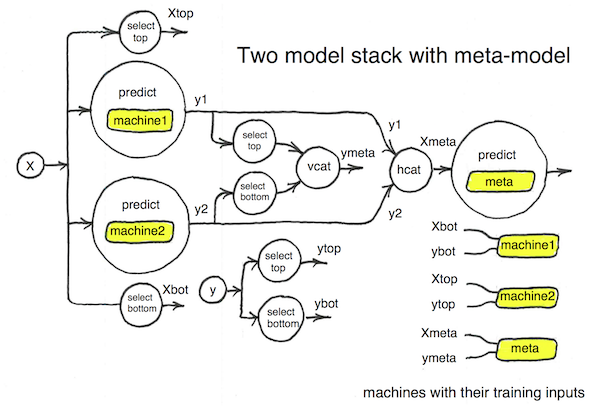A pure Julia machine learning framework.
MLJ aims to be a flexible framework for combining and tuning machine learning models, written in the high performance, rapid development, scientific programming language, Julia. MLJ is work in progress and new collaborators are being sought.
Click here if your are interested in contributing.
The MLJ project is partly inspired by MLR (recent slides 7/18.) For an earlier proof-of-concept, see this branch and this poster summary.
Packages wishing to implement the MLJ interface for their algorithms should import MLJBase.
-
Automated tuning of hyperparameters, including composite models with nested parameters. Tuning implemented as a wrapper, allowing composition with other meta-algorithms. ✔
-
Option to tune hyperparameters using gradient descent and automatic differentiation (for learning algorithms written in Julia).
-
Data agnostic: Train models on any data supported by the Tables.jl interface. ✔
-
Intuitive syntax for building arbitrarily complicated learning networks .✔
-
Learning networks can be exported as self-contained composite models ✔, but common networks (e.g., linear pipelines, stacks) come ready to plug-and-play.
-
Performant parallel implementation of large homogeneous ensembles of arbitrary models (e.g., random forests). ✔
-
Task interface matches machine learning problem to available models.
-
Benchmarking a battery of assorted models for a given task.
-
Automated estimates of cpu and memory requirements for given task/model.
- Julia 1.0 or higher
In the Julia REPL:
]add "https://github.com/wildart/TOML.jl"
add "https://github.com/alan-turing-institute/MLJBase.jl"
add "https://github.com/alan-turing-institute/MLJModels.jl"
add "https://github.com/alan-turing-institute/MLJ.jl"For more detail and features, see the evolving MLJ tour.
using MLJ
using DataFrames
task = load_boston()
X, y = X_and_y(task);
X = DataFrame(X) # or any other tabular format supported by Tables.jl
train, test = partition(eachindex(y), 0.7); # 70:30 splitA model is a container for hyperparameters:
knn_model=KNNRegressor(K=10)# KNNRegressor{Float64} @ 1…90:
target_type => Float64
K => 10
metric => euclidean (generic function with 1 method)
kernel => reciprocal (generic function with 1 method)
Wrapping the model in data creates a machine which will store training outcomes (called fit-results):
knn = machine(knn_model, X, y)# Machine{KNNRegressor{Float64}} @ 9…72:
model => KNNRegressor{Float64} @ 1…90
fitresult => (undefined)
cache => (undefined)
args => (omitted Tuple{DataFrame,Array{Float64,1}} of length 2)
report => empty Dict{Symbol,Any}
rows => (undefined)
Training on the training rows and evaluating on the test rows:
fit!(knn, rows=train)
yhat = predict(knn, X[test,:])
rms(y[test], yhat)┌ Info: Training Machine{KNNRegressor{Float64}} @ 9…72.
└ @ MLJ /Users/anthony/Dropbox/Julia7/MLJ/src/machines.jl:69
8.090639098853249
Or, in one line:
evaluate!(knn, resampling=Holdout(fraction_train=0.7))8.090639098853249
Changing a hyperparameter and re-evaluating:
knn_model.K = 20
evaluate!(knn, resampling=Holdout(fraction_train=0.7))8.41003854724935
A simple example of a composite model is a homogeneous ensemble. Here's a bagged ensemble model for 20 K-nearest neighbour regressors:
ensemble_model = EnsembleModel(atom=knn_model, n=20) # DeterministicEnsembleModel @ 5…24:
atom => KNNRegressor{Float64} @ 1…90
weights => 0-element Array{Float64,1}
bagging_fraction => 0.8
rng_seed => 0
n => 20
parallel => true
Let's simultaneously tune the ensemble's bagging_fraction and the K-nearest neighbour hyperparameter K. Since one of these models is a field of the other, we have nested hyperparameters:
params(ensemble_model)Params(:atom => Params(:target_type => Float64, :K => 20, :metric => MLJ.KNN.euclidean, :kernel => MLJ.KNN.reciprocal), :weights => Float64[], :bagging_fraction => 0.8, :rng_seed => 0, :n => 20, :parallel => true)
To define a tuning grid, we construct ranges for the two parameters and collate these ranges following the same pattern above (omitting parameters that don't change):
B_range = range(ensemble_model, :bagging_fraction, lower= 0.5, upper=1.0, scale = :linear)
K_range = range(knn_model, :K, lower=1, upper=100, scale=:log10)
nested_ranges = Params(:atom => Params(:K => K_range), :bagging_fraction => B_range)Params(:atom => Params(:K => NumericRange @ 1…75), :bagging_fraction => NumericRange @ 1…56)
Now we choose a tuning strategy, and a resampling strategy (for estimating performance), and wrap these strategies around our ensemble model to obtain a new model:
tuning = Grid(resolution=12)
resampling = CV(nfolds=6)
tuned_ensemble_model = TunedModel(model=ensemble_model,
tuning=tuning, resampling=resampling, nested_ranges=nested_ranges)# DeterministicTunedModel @ 1…93:
model => DeterministicEnsembleModel @ 5…24
tuning => Grid @ 1…37
resampling => CV @ 6…31
measure => nothing
operation => predict (generic function with 19 methods)
nested_ranges => Params(:atom => Params(:K => NumericRange @ 1…75), :bagging_fraction => NumericRange @ 1…56)
report_measurements => true
Fitting the corresponding machine tunes the underlying model (in this case an ensemble) and retrains on all supplied data:
tuned_ensemble = machine(tuned_ensemble_model, X[train,:], y[train])
fit!(tuned_ensemble);┌ Info: Training Machine{MLJ.DeterministicTunedMo…} @ 1…05.
└ @ MLJ /Users/anthony/Dropbox/Julia7/MLJ/src/machines.jl:69
Searching a 132-point grid for best model: 100%[=========================] Time: 0:01:20
┌ Info: Training best model on all supplied data.
└ @ MLJ /Users/anthony/Dropbox/Julia7/MLJ/src/tuning.jl:130
tuned_ensemble.reportDict{Symbol,Any} with 4 entries:
:measurements => [7.03102, 6.09291, 6.05707, 5.93617, 5.86848, 5.73299, 5…
:models => DeterministicEnsembleModel{Tuple{Array{Float64,2},Array{…
:best_model => DeterministicEnsembleModel @ 3…49
:best_measurement => 5.46102
best_model = tuned_ensemble.report[:best_model]
@show best_model.bagging_fraction
@show best_model.atom.Kbest_model.bagging_fraction = 0.7272727272727273
(best_model.atom).K = 100
Predecessors of the current package are AnalyticalEngine.jl and Orchestra.jl, and Koala.jl. Work continued as a research study group at the University of Warwick, beginning with a review of existing ML Modules that were available in Julia at the time (in-depth, overview).
Further work culminated in the first MLJ proof-of-concept


